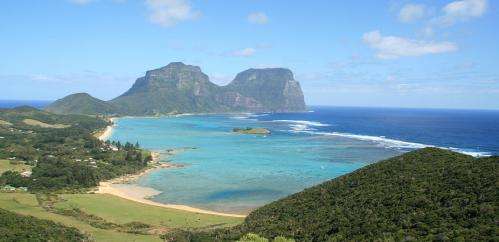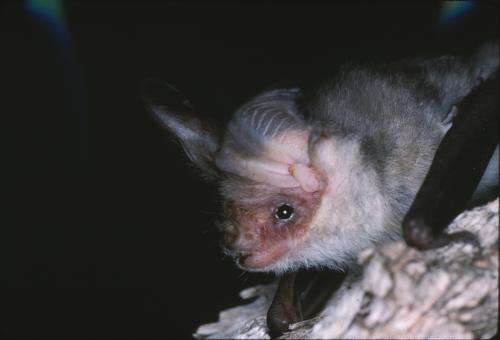The paradise of Lord Howe Island has a grim history of biodiversity loss. Credit: Roberta W B
Some threatened species are familiar and well-known; others are obscure. The Lord Howe Long-eared Bat may be the epitome of obscure. Were it not for the fluke discovery of a singe tiny but distinctive skull (less than 3cm in length) in Gooseberry Cave on Lord Howe Island in 1972, we wouldn't know that this species ever existed.
That single skull remains the only tangible and unequivocal evidence of this species. Analysis indicated that the skull had been deposited 50-100 years before its discovery.
There is a thin narrative contextualising the skull. Naturalists visiting Lord Howe Island in the 1880s observed, but didn't collect, two different-sized bats, one small and one very small.
The former probably represents the only reported sightings of the Lord Howe Long-eared Bat; the latter was almost certainly the Large Forest Bat (Vespadelus darlingtoni, the common name being perhaps unreasonably ambitious). This was a relatively wide-ranging species for which specimens were subsequently collected on Lord Howe Island (and elsewhere), and which appears to have persisted.
Lord Howe Island is a small (15 km2) rugged oceanic island off New South Wales with a remarkably long history of isolation. Before colonisation it supported extraordinarily high numbers of endemic plant and animal species, with this unique and rich biodiversity recognised in World Heritage listing.
Many of the endemic species were exterminated by early settlers or by the non-native species that they deliberately or accidentally introduced. Others have persisted, just: many are now perilously close to extinction.
It is the lot of islands, particularly oceanic islands, that they provide a fertile furnace of evolution, but that once their isolation is broken, their weird constellation of unique species proves remarkably fragile to new threats.
Status
Not unreasonably given the lack of any confirmed records of live individuals, and the absence of evidence of existence, this species is considered as Extinct in the Australian list of threatened species under the Environment Protection and Biodiversity Conservation Act.
That status is supported by the failure of recent searches of the small satellite islands around Lord Howe, many of which do not yet have the same threatening factors that subverted the Lord Howe Island ecology.
While there are no pictures of the Lord Howe Long-eared Bat, this closely-related Gould’s Long-eared Bat gives us some idea. Credit: Department of Environment Primary Industries
A separate assessment of status in 2008, by the International Union for the Conservation of Nature (for the Red List) was more equivocal, and based on some ongoing anecdotal sightings by island residents of purportedly two differently-sized bats, considered that the species could not yet be called as Extinct, but rated it instead as Critically Endangered.
Extinction is indeed difficult to prove, but the IUCN assessment is probably unrealistically hopeful.
Threats
Given the entire sum of knowledge of this species could be readily tucked away in a matchbox, or encapsulated in a single sentence, it is impossible now to resolve the factor(s) that caused its extinction.
The most plausible explanation is predation by Black Rats. These were accidentally introduced to Lord Howe Island in 1918, and rapidly became very abundant. Black Rats have form: they have been demonstrated unequivocally to have caused the loss of one of New Zealand's few but particularly odd native bats.
But there are other possible causes. In a nursery rhyme vortex, islanders introduced owls to attempt to control the rats, and it is possible that the owls themselves rather than the rats caused the loss of the Lord Howe Long-eared Bat.
Threats that may be bearable on mainland areas become magnified on small islands. Given limited space and resources, most island species have small population sizes; over long periods with few or no competitors or predators, many have developed predator-naïve traits and low reproductive outputs: their ecologies and life histories are highly fallible.
Strategy
It is too late to craft a strategy for the survival of this species. But approaches that could have saved this species may still prove useful for many others.
A well-considered biodiversity management plan has been developed for Lord Howe Island. But it has not yet been adequately resourced or implemented. A plan to eradicate black rats from the island is proceeding slowly. It will be a difficult and complex task, but many conservation challenges can only be met by such determined and ambitious responses.
Conclusion
This is a somewhat unusual case of an extinction going long unnoticed: indeed, the species itself was not noticed until decades after it disappeared. This story has more messages than one might expect from the insubstantiality of its core.
The first message concerns the threadbare state of our knowledge of this continent's biodiversity, and of its fate. There is a major divide between, on the one hand, knowing of a species and its extinction and, on the other hand, never knowing that a species existed or became extinct. In this case, the serendipitous find of a single skull allowed us to cross that divide.
It is likely that there are many other species that have become extinct in Australia since European settlement, but for which we haven't found the evidence of their existence and loss: our current extinction statistics are likely to be substantial under-estimates.
As a corollary, there are also likely to be many unknown but still extant species that may be facing imminent extinction, and—at a time when resources for survey and taxonomy are dwindling—many of these are likely to disappear before they have been discovered.
Another lesson relates to the biodiversity value of Australian islands, and the tenuousness of existence of much of that biodiversity. It is time for formal recognition under the EPBC Act for biodiversity-rich islands, and the development of adequate and proactive biosecurity strategies for these critically important parts of our natural heritage.
The strikingly parallel case of the very recent extinction of the Christmas Island Pipistrelle suggests that we still haven't heeded the lessons that may be learnt from the extinction of the Lord Howe Long-eared Bat.
Source: The Conversation
This story is published courtesy of The Conversation (under Creative Commons-Attribution/No derivatives).
![]()


.jpg)




















